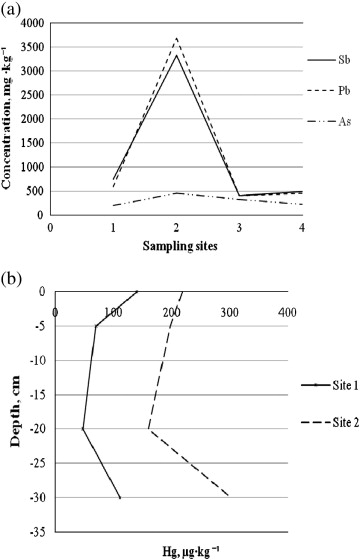
Fig. a) Distribution of Sb, Pb and As in the surface soils at four sampling sites. b) Hg distribution throughout soil profile at site 1 and site 2.
Soil samples were collected from an antimony smelting site in Guangxi Zhuang Autonomous Region, China, at four locations characterized by different land usage, including two cultivated sites: one formerly cultivated and one uncultivated. Surface soils from all four sites were heavily polluted by toxic metals including antimony (Sb), lead (Pb) and arsenic (As), and their concentrations were 410-3330 mg.kg(-1). 410.3690 mg.kg(-1) and 200-460 mg.kg(-1), respectively. In the uncultivated area metal levels were 1.4-6.2 times higher as compared to the formerly and currently agriculture land. Lower levels at the cultivated sites may have resulted from an accumulation of airborne particles by vegetation and lower contents in the surface soil. However, the elevated mercury (Hg) content may reflect both natural and anthropogenic origins in this smelting site. Soil-derived humic acid (HA) from the smelting site reacted directly with Sb (III) aqueous solutions with concentrations of 12,71 and 143 mg.g(-1). The maximum Sb (III) binding to the soil-derived HA was 253 mu mol.g(-1) (added concentration of 71 mg.g(-1)) and showed more binding (up to 50%) at lower Sb content. (C) 2010 Elsevier B.V. All rights reserved.
| Publication name |
MICROCHEMICAL JOURNAL Volume: 98 Issue: 1 Pages: 15-20 Published: MAY 2011 |
| Author(s) |
Tserenpil, Sh; Liu Cong-Qiang |
| Corresponding author |
Tserenpil, Sh
tserenpil.sh@gmail.com
CAS, Inst Geochem, State Key Lab Environm Geochem, Guiyang 550002, Peoples R China |